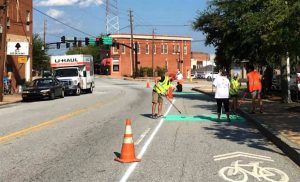Giant City Cycling Pop-Up Offers Bike Lane Lessons
Read the full article online at https://nextcity.org
 “How do you get a city more accustomed to biking trails to pedal the streets? Paint a whole lot of lanes. Macon, Georgia, population 150,000, was able to increase cyclist counts nearly tenfold during a one-week pop-up bike network, which at 8 miles, may have been the largest such temporary installation ever. Macon has had an 11-mile riverfront trail, where cyclists can travel from historic monument to playground to park without ever touching a street. But that, says Josh Rogers, president and CEO of the nonprofit NewTown Macon, which works to revitalize the city’s downtown, was exactly the problem. “People drive to the trail and then unload their bike and ride.” The thought that there might be a better way stemmed from a 2015 trip to Copenhagen (funded by the Knight Foundation and organized by 8 80 Cities, an international mobility-focused nonprofit).
“How do you get a city more accustomed to biking trails to pedal the streets? Paint a whole lot of lanes. Macon, Georgia, population 150,000, was able to increase cyclist counts nearly tenfold during a one-week pop-up bike network, which at 8 miles, may have been the largest such temporary installation ever. Macon has had an 11-mile riverfront trail, where cyclists can travel from historic monument to playground to park without ever touching a street. But that, says Josh Rogers, president and CEO of the nonprofit NewTown Macon, which works to revitalize the city’s downtown, was exactly the problem. “People drive to the trail and then unload their bike and ride.” The thought that there might be a better way stemmed from a 2015 trip to Copenhagen (funded by the Knight Foundation and organized by 8 80 Cities, an international mobility-focused nonprofit).
“It was like a lightbulb moment,” Rogers recalls. “We love biking along the river, why don’t we do this along every street?” At the time, Macon had exactly three blocks with “some form of bike infrastructure” in its downtown, “and they weren’t connected. They’re three random blocks,” Rogers says. On an average day, the number of people riding bikes in downtown Macon was 23. In an effort to change that, NewTown, 8 80 Cities and other partners in and outside government decided to test on-street biking at a large scale and won a $150,000 grant from the Knight Cities Challenge to implement the project. “Then we had to figure out how to actually do it,” Rogers says. They got advice and help from Jason Roberts of Better Block, which focuses on healthy built environments. Roberts admits that the biggest pop-up bike infrastructure they’d put in prior to Macon’s was less than a mile long. “I didn’t find that out until we were out laying out the path.” Regardless, 498 cans of paint, five days, 80 volunteers and 180 bollards later, the pop-up bike network was open. It was intended to be a weekend-long test, but when Mayor Robert Reichert cut the ribbon, he declared it would stay up for a week.”
Read the full article online at https://nextcity.org


